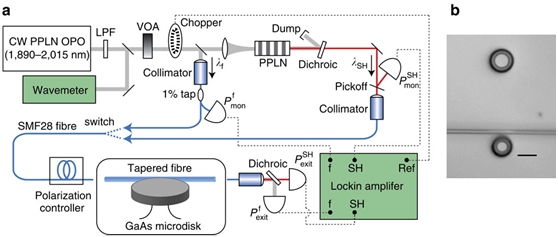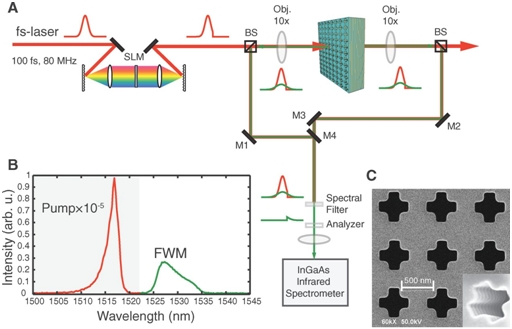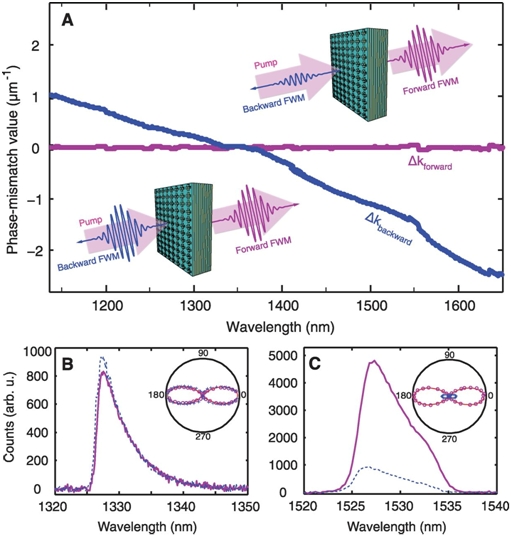1.在GaAs 回音壁微腔中利用 对称结构的准相位匹配特性产生二倍频(Second-harmonic generation using
对称结构的准相位匹配特性产生二倍频(Second-harmonic generation using -quasi-phasematching ina GaAswhispering-gallery-mode microcavity)【Nature. Communications】
-quasi-phasematching ina GaAswhispering-gallery-mode microcavity)【Nature. Communications】
doi: 10.1038/ncomms4109
published: 2014.01.17
内容介绍:
拥有 对称
对称 结构的晶体,比如GaAs,可以不需要极化、形成双晶或其它使晶畴反转的工程手段就可以实现准相位匹配,从而提升光频非线性转换的效率。
结构的晶体,比如GaAs,可以不需要极化、形成双晶或其它使晶畴反转的工程手段就可以实现准相位匹配,从而提升光频非线性转换的效率。 对称结构意味着绕
对称结构意味着绕 轴旋转90度,晶轴方向倒置。那么,比如在GaAs回音壁微盘中,当光绕着
轴旋转90度,晶轴方向倒置。那么,比如在GaAs回音壁微盘中,当光绕着 轴行走时,它会周期性的遇到反转的晶轴,而这正是实现准相位匹配的基础。另外,微盘谐振腔可以通过谐振场增强,在很小的微米尺度中进一步提升光频转换的效率。这种微盘可以方便的被集成到集成光电路中,作为紧凑的频率转换器、辐射源、或纠缠光子源。这篇文章实验上第一次利用这种
轴行走时,它会周期性的遇到反转的晶轴,而这正是实现准相位匹配的基础。另外,微盘谐振腔可以通过谐振场增强,在很小的微米尺度中进一步提升光频转换的效率。这种微盘可以方便的被集成到集成光电路中,作为紧凑的频率转换器、辐射源、或纠缠光子源。这篇文章实验上第一次利用这种 结构的回音壁微腔观察到了二倍频现象。本文用拉锥光纤和5um直径微腔耦合,归一化转换效率达到5*10-5mw-1。理论上预测,考虑光纤-微盘的散射,归一化转换效率应该在3*10-3mw-1。
结构的回音壁微腔观察到了二倍频现象。本文用拉锥光纤和5um直径微腔耦合,归一化转换效率达到5*10-5mw-1。理论上预测,考虑光纤-微盘的散射,归一化转换效率应该在3*10-3mw-1。

图1(a)倍频实验装置结构图(b)GaAs微盘和光纤耦合显微

图2(a)上图:弱光下基频谐振,倍频不谐振;下图;倍频信号在不同基频功率下随基频频率的变化关系(b)倍频信号强度与基频光强度在对数坐标下的关系,斜率2.15+0.1 (c)二倍频转化效率随基频光强的关系,约为5*10-5mw-1,大光强下的走离是因为谐振峰的漂移
2.在非线性传输中不需要相位匹配的零折射率材料(Phase Mismatch–Free Nonlinear Propagation in Optical Zero-Index Materials)【Science】
doi: 10.1126/science.1244303
published: 2013.09.06
内容介绍:
在相干非线性光学过程中,比如频率转换和参量放大,相位匹配是非常重要的。相配失配会造成微观非线性源产生的信号不能相干叠加,而是相干相消使得非线性效率非常低。这篇文章在零折射率光学超材料中报道了一种不需要相位匹配的非线性产生过程。与传统材料中弥补相位失配技术不同的是,零折射率材料根本不需要相位匹配,而且会在前向和后向同时产生有效的非线性信号。这里文章,利用单个脉冲内的的四波混频来证明这个不需要相位匹配的非线性过程,而且在前后两个方向观察到了几乎同等强度的非线性信号。这种光学超材料中对相位匹配的不需要,将在多个方向的频率转换和纠缠光子产生上有应用。

图3(A)实验装置图(B)四波混频信号和泵浦信号的对比(C)零折射率超材料的电镜图

图4(A)前向和后向的相位失配随波长的变化关系
(B)零折射率情况下,前向后向强度几乎一致(C)负折射率时,前向强度比后向大
(B、C)图中的插图是前/后向强度随偏振的关系,满足cos6(θ)公式
二、简讯:
doi:10.1038/nphoton.2013.253
published:2013.09.15
Graphene-based photodetectors have attracted strong interest for their exceptional physical properties, which include an ultrafast response across a broad spectrum, a strong electron–electron interaction and photocarrier multiplication. However, the weak optical absorption of grapheme limits its photoresponsivity. To address this, graphene has been integrated into nanocavities, microcavitiesand plasmon resonators, but these approaches restrict photodetection to narrow bands. Hybrid graphene–quantum dot architectures can greatly improve responsivity, but at the cost of response speed. Here, we demonstrate a waveguide-integrated graphenephotodetector that simultaneously exhibits high responsivity, high speed and broad spectral bandwidth. Using a metal-doped graphene junction coupled evanescently to the waveguide, the detector achieves a photoresponsivity exceeding 0.1 A W−1 together with a nearly uniform response between 1450 and 1590 nm. Under zero-bias operation, we demonstrate response rates exceeding 20 GHz and an instrumentation-limited 12 Gbit s−1 optical data link.
doi:10.1038/nature12307
published:2013.08.08
Abstract:
Monitoring a mechanical object’s motion, even with the gentle touch of light, fundamentally alters its dynamics. The experimental manifestation of this basic principle of quantum mechanics, its link to the quantum nature of light and the extension of quantum measurement to the macroscopic realm have all received extensive attention over the past half-century. The use of squeezed light, with quantum fluctuations below that of the vacuum field, was proposed nearly three decades ago as a means of reducing the optical read-out noise in precision force measurements. Conversely, it has also been proposed that a continuous measurement of a mirror’s position with light may itself give rise to squeezed light. Such squeezed-light generation has recently been demonstrated in a system of ultracold gas-phase atoms whose centre-of-mass motion is analogous to the motion of a mirror. Here we describe the continuous position measurement of a solid-state, optomechanical system fabricated from a silicon microchip and comprising a micromechanical resonator coupled to a nanophotonic cavity. Laser light sent into the cavity is used to measure the fluctuations in the position of the mechanical resonator at a measurement rate comparable to its resonance frequency and greater than its thermal decoherence rate. Despite the mechanical resonator’s highly excited thermal state (104 phonons), we observe, through homodyne detection, squeezing of the reflected light’s fluctuation spectrum at a level 4.5 ± 0.2 per cent below that of vacuum noise over a bandwidth of a few megahertz around the mechanical resonance frequency of 28 megahertz. With further device improvements, on-chip squeezing at significant levels should be possible, making such integrated microscale devices well suited for precision metrology applications.
doi: 10.1038/NMAT3819
published:2013.09.08
Abstract:
Stimuli-responsive nanomaterials are increasingly important in a variety of applications such asbiosensing, molecular imaging,drug delivery and tissue engineering. For cancer detection, a paramount challenge still exists in the search for methodsthat can illuminate tumours universally regardless of their genotypes and phenotypes. Here we capitalized on the acidic,angiogenictumour microenvironment to achieve the detection of tumour tissues in a wide variety of mouse cancer models.This was accomplished using ultra pH-sensitive fluorescent nanoprobes that have tunable, exponential fluorescence activationon encountering subtle, physiologically relevant pH transitions. These nanoprobes were silent in the circulation, and thenstrongly activated (>300-fold) in response to the neovasculature or to the low extracellular pH in tumours. Thus, we haveestablished non-toxic, fluorescent nanoreporters that can nonlinearly amplify tumourmicroenvironmental signals, permittingthe identification of tumour tissue independently of histological type or driver mutation, and detection of acute treatmentresponses much more rapidly than conventional imaging approaches.
doi: 10.1038/NNANO.2012.51
published:2012.04.15
Abstract:
Existing methods for the optical detection of single moleculesrequire the molecules to absorb light to produce fluorescenceor direct absorption signals. This limits the range of species that can be detected, because most molecules arepurely refractive. Metal nanoparticles or dielectric resonatorscan be used to detect non-absorbing moleculesbecause local changes in the refractive index produce a resonance shift. However, current approaches only detect single molecules when the resonance shift is amplified by a highlypolarizable labelor by a localized precipitation reactionon the surface of a nanoparticle. Without such amplification,single-molecule events can only be identified in a statisticalway. Here, we report the plasmonic detection of singlemolecules in real time without the need for labelling or amplification. Our sensor consists of a single gold nanorod coated withbiotin receptors, and the binding of single proteins is detectedby monitoring the plasmon resonance of the nanorod with a sensitivephotothermal assay. The sensitivity of our deviceis ∼700 times higher than state-of-the-art plasmon sensorsand is intrinsically limited by spectral diffusion of the surface plasmon resonance.
供稿:徐颖鑫 李志勇 林星 王依霈 虞绍良







